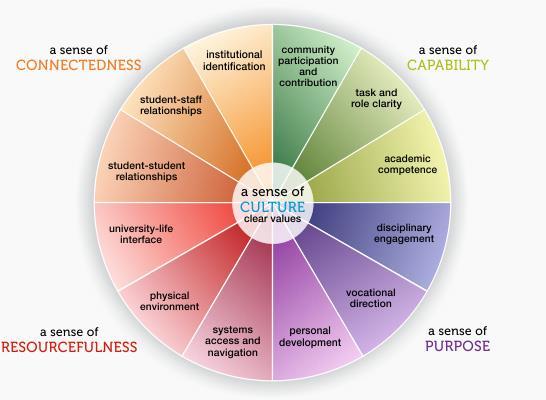Published on: 10/07/2023 · Last updated on: 21/05/2025
Course-wide approach
Supporting effective transition is a key tenet of the course-wide approach to curriculum development. It is part of our active promotion of an inclusive curriculum and supporting the needs of all learners, as well as designing for the needs of our future students.
Why is transition important and what contributes to effective transition?
Colleagues across the University work collaboratively to support effective transition, from the work we do with prospective students and their supporters, through to planning induction and specific initiatives to help particular groups in the practical transition to Bath, and support into and out of placements.
Your curriculum plays a vital role in supporting students’ transition to a new educational environment. As you plan the start of your course, you have the opportunity to learn more about what your students come in with, set clear roles, responsibilities and expectations, scaffold learning effectively towards their first assessment/s and create a sense of academic belonging within your course, where your students come to feel part of your learning community. Not all students have the same support outside of the academic environment, and there may be particular elements of the academic and broader social transition that can be especially difficult for some groups of students.
What is the evidence base for transition?
A useful model for understanding the important factors that contribute to student satisfaction, engagement and persistence in HE is the ‘Five Senses of Success’ (Lizzio and Wilson, 2006, 2010). This model is focused on building an academic culture which develops the student’s sense of connectedness, capability, purpose, and resourcefulness. This model underpins the institutional approach to induction and transition at Bath.
Research conducted in the UK (Thomas, 2012; 2017) suggests student belonging is achieved through:
- Supportive peer relations
- Meaningful interaction between staff and students
- Developing knowledge, confidence and identity as successful HE learners
- An HE experience relevant to students’ interests and future goals

Supporting effective transition in the curriculum
- Using a self-diagnostic tool with students can help them reflect on their skills development and gives teaching staff an idea of whole-cohort patterns of difficulty. The Skills Centre tool is used by a number of departments as a transition resource. Skills centre homepage.
- Explicitly and intentionally scaffolding key skills in the first year. Find out more in this EduFest 2021 presentation from the Curriculum Development team which looks particularly at scaffolding independent learning.
- The whole department being aware of Head of Department/Director of Studies induction talk content and where they can reinforce key messages, especially around roles and responsibilities, and where students can go for help (and in what circumstances), in their first and ongoing interactions with students. Induction can be overwhelming and common feedback is that students are overloaded, so consider where you can refer to key ideas or concepts as the first semester progresses, e.g. academic integrity is introduced at induction, but can be followed up as students build towards their first assignment.
- Using meetings with Academic Advisors/tutorials to explore where students are at in terms of skills and knowledge. Some departments timetable common tutorial topics to ensure all students have covered certain bases; you may want to use other ‘open’ sessions to explore gaps which the cohort has identified through a skills audit or tool as needing attention.
- Using meetings with Academic Advisors/tutorials to explicitly address wellbeing; some colleagues use the Be Well campaign to frame discussions around wellbeing with students and have them talk about one action they will take in each area.
Further resources and support
Your student experience and engagement staff, as well as your own student engagement work, will give you lots of evidence as to how your students experience the transition to your course; starting with identified areas for development in NSS is a good way to begin exploring the undergraduate student standpoint.
These videos produced by our Student Engagement Ambassadors have been incorporated into some pre-arrival communications incoming undergraduates received in September 2019. They can help you get a sense of what students experience when they come to Bath: